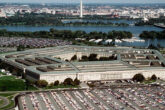March 01, 2021
DoD weather capabilities have lagged; Space Force can turn that around
Just before dawn on August 30, 1776, a bank of fog crawled over New York’s East River, concealing George Washington’s beleaguered Continentals as they slipped away to safety and out of reach of the surrounding British forces. Washington had pulled off the miraculous evacuation of more than 9,000 soldiers from Brooklyn without a single casualty thanks to a fortunate turn of the weather.
Access to weather information is an enduring component of successful military operational planning, and similar episodes are well known in the annals of American military history, from the Battle of Long Island to D-Day to the infamous dust storms in the first Iraq War.
Today, U.S. service members are at risk of losing the most up-to-date knowledge of weather conditions.
For much of that history, America’s warfighters had to do without the highly advanced technological tools that forecast weather systems. These tools are now readily available, but today U.S. service members are at risk of losing the most up-to-date knowledge of weather conditions.
A gap in weather capabilities has been widening. The Defense Meteorological Satellite Program (DMSP) is at the end of its service life and follow-on programs have ranked low in the Air Force’s priority list. All of this could — and should — change with the Biden administration’s revitalized emphasis on climate change as an “essential element of our national security.”
Read the full article from Space News.
More from CNAS
-
The Department of Defense’s Breakthrough Nuclear Moment Risks Slipping Away
Unless they act, the Department of Defense’s breakthrough nuclear moment may vanish before it really happens....
By Will Rogers
-
DEFAERO Strategy Series [Apr 09, 25] CNAS' Becca Wasser and Phil Sheers on Revitalizing the U.S. Defense Industrial Base
On this episode of the Defense & Aerospace Report Strategy Series, sponsored by General Atomics Aeronautical Systems, Becca Wasser and Phil Sheers of the Center for a New Amer...
By Becca Wasser & Philip Sheers
-
From Production Lines to Front Lines
Executive Summary The U.S. defense industrial base (DIB) is struggling to meet the demands of the current strategic environment—let alone prepare for a potential conflict agai...
By Becca Wasser & Philip Sheers
-
The Pentagon’s Endangered Brain Trust
In this environment, sound assessments of emerging threats and new ideas to counter them will be especially vital....
By Dr. Andrew Krepinevich, Jr.




